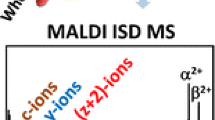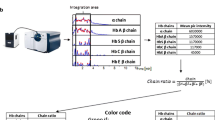Abstract
Hemoglobin disorder diagnosis is a complex procedure combining several analytical steps. Due to the lack of specificity of the currently used protein analysis methods, the identification of uncommon hemoglobin variants (proteoforms) can become a hard task to accomplish. The aim of this work was to develop a mass spectrometry-based approach to quickly identify mutated protein sequences within globin chain variants. To reach this goal, a top-down electron transfer dissociation mass spectrometry method was developed for hemoglobin β chain analysis. A diagnostic product ion list was established with a color code strategy allowing to quickly and specifically localize a mutation in the hemoglobin β chain sequence. The method was applied to the analysis of rare hemoglobin β chain variants and an Aγ-β fusion protein. The results showed that the developed data analysis process allows fast and reliable interpretation of top-down electron transfer dissociation mass spectra by nonexpert users in the clinical area.




Similar content being viewed by others
References
Modell B, Darlison M (2008) Global epidemiology of haemoglobin disorders and derived service indicators. Bull World Health Organ 86:480–487
Old JM (2003) Screening and genetic diagnosis of haemoglobin disorders. Blood Rev 17(1):43–53
A database of human hemoglobin variants and thalassemias. Available from: http://globin.cse.psu.edu/hbvar/manu.html
Zhang Z, Wu S, Stenoien DL, Pasa-Tolic L (2014) High-throughput proteomics. Annu Rev Anal Chem 7(1):427–454
Théberge R, Infusini G, Tong W, McComb ME, Costello CE (2011) Top-down analysis of small plasma proteins using an LTQ-Orbitrap. Potential for mass spectrometry-based clinical assays for transthyretin and hemoglobin. Int J Mass Spectrom 300(2–3):130–142
Smith LM, Kelleher NL, Consortium for Top Down Proteomics (2013) Proteoform: a single term describing protein complexity. Nat Meth 10(3):186–187
Zubarev RR, Horn DM, Fridriksson EK, Kelleher NL, Kruger NA, Lewis MA, Carpenter BK, McLafferty FW (2000) Electron capture dissociation for structural characterization of multiply charged protein cations. Anal Chem 72(3):563
Syka JEP, Coon JJ, Schroeder MJ, Shabanowitz J, Hunt DF (2004) Peptide and protein sequence analysis by electron transfer dissociation mass spectrometry. Proc Natl Acad Sci U S A 101(26):9528–9533
Boemer F, Cornet Y, Libioulle C, Segers K, Bours V, Schoos R (2011) 3-years experience review of neonatal screening for hemoglobin disorders using tandem mass spectrometry. Clin Chim Acta 412(15–16):1476–1479
Daniel YA, Turner C, Haynes RM, Hunt BJ, Dalton RN (2005) Rapid and specific detection of clinically significant haemoglobinopathies using electrospray mass spectrometry–mass spectrometry. Br J Haematol 130(4):635–643
Hachani J, Duban-Deweer S, Pottiez G, Renom G, Flahaut C, Périni JM (2011) MALDI-TOF MS profiling as the first-tier screen for sickle cell disease in neonates: Matching throughput to objectives. Proteomics Clin Appl 5(7–8):405–414
Edwards RL, Creese AJ, Baumert M, Griffiths P, Bunch J, Cooper HJ (2011) Hemoglobin variant analysis via direct surface sampling of dried blood spots coupled with high-resolution mass spectrometry. Anal Chem 83(6):2265–2270
Coelho Graça D, Lescuyer P, Clerici L, Tsybin YO, Hartmer R, Meyer M, Samii K, Hochstrasser DF, Scherl A (2012) Electron transfer dissociation mass spectrometry of hemoglobin on clinical samples. J Am Soc Mass Spectrom 23(10):1750–1756
Edwards RL, Martin NJ, Cooper HJ (2013) Hemoglobin variant analysis of whole blood and dried blood spots by MS. Bioanalysis 5(16):2043–2052
Edwards RL, Griffiths P, Bunch J, Cooper HJ (2014) Compound heterozygotes and beta-thalassemia: top-down mass spectrometry for detection of hemoglobinopathies. Proteomics 14(10):1232–1238
Edwards RL, Griffiths P, Bunch J, Cooper HJ (2012) Top-down proteomics and direct surface sampling of neonatal dried blood spots: diagnosis of unknown hemoglobin variants. J Am Soc Mass Spectrom 23(11):1921–1930
Fornelli L, Parra J, Hartmer R, Stoermer C, Lubeck M, Tsybin YO (2013) Top-down analysis of 30–80 kDa proteins by electron transfer dissociation time-of-flight mass spectrometry. Anal Bioanal Chem 405(26):8505–8514
Hartmer RG, Kaplan DA, Stoermer C, Lubeck M, Park MA (2009) Data-dependent electron transfer dissociation of large peptides and medium size proteins in a QTOF instrument on a liquid chromatography timescale. Rapid Commun Mass Spectrom 23(15):2273–2282
ProteinProspector. Available from: http://prospector.ucsf.edu/prospector/cgi-bin/msform.cgi?form=msproduct
Price P (1991) Standard definitions of terms relating to mass spectrometry: a report from the committee on measurements and standards of the American Society for Mass Spectrometry. J Am Soc Mass Spectrom 2(4):336–348
Wilcox I, Boettger K, Greene L, Malek A, Davis L, Steinberg MH, Luo HY, Chui DH (2009) Hemoglobin Kenya composed of α- and (Aγβ)-fusion-globin chains, associated with hereditary persistence of fetal hemoglobin. Am J Hematol 84(1):55–58
Acosta-Martin AE, Coelho Graça D, Antinori P, Clerici L, Hartmer R, Meyer M, Hochstrasser D, Samii K, Lescuyer P, Scherl A (2013) Quantitative mass spectrometry analysis of intact hemoglobin A2 by precursor Ion isolation and detection. Anal Chem 85(16):7971–7975
Acknowledgments
This study was supported by the Swiss National Science Foundation Grant No. 32003B_143809 and by the Ernst & Lucie Schmidheiny Foundation. The authors thank Paola Antinori, Fabienne Jeanneret, and HuiSong Pak for their scientific support and encouraging discussions.
Author information
Authors and Affiliations
Corresponding author
Electronic supplementary material
Below is the link to the electronic supplementary material.
ESM 1
(PDF 500 kb)
Rights and permissions
About this article
Cite this article
Coelho Graça, D., Hartmer, R., Jabs, W. et al. Identification of hemoglobin variants by top-down mass spectrometry using selected diagnostic product ions. Anal Bioanal Chem 407, 2837–2845 (2015). https://doi.org/10.1007/s00216-015-8525-5
Received:
Revised:
Accepted:
Published:
Issue Date:
DOI: https://doi.org/10.1007/s00216-015-8525-5




